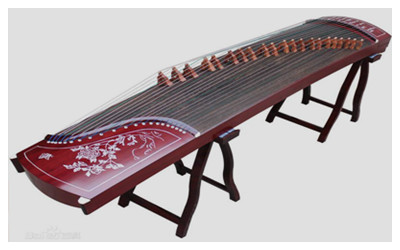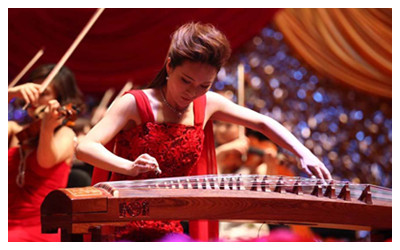Skype: neodalle-travel
Tel: +86 135 7447 2266
E-mail: sales@visitaroundchina.com

 Guzheng 古筝, or Zheng 筝, also known as Chinese zither, is part of the zither family and is one of China's unique and important national musical instruments. Guzheng is often used in solo, ensemble, instrumental ensemble and accompaniment of singing, dancing, opera. Because of its wide range and beautiful tone, it is called "the king of music" and also called "the oriental piano".
Guzheng 古筝, or Zheng 筝, also known as Chinese zither, is part of the zither family and is one of China's unique and important national musical instruments. Guzheng is often used in solo, ensemble, instrumental ensemble and accompaniment of singing, dancing, opera. Because of its wide range and beautiful tone, it is called "the king of music" and also called "the oriental piano".
The history of Guzheng can be traced back 2500 years to documents written in the Qin dynasty (before 206 B.C.) The Guzheng was originally called simply Zheng, but as the instrument developed an extended and ancient history the prefix “Gu” was added. “Gu” means ancient in Chinese and its combination with Zheng stresses not only the age of the instrument itself but also the potential the instrument has for having a substantial cultural place within a nation that has an extensive cultural past. The Guzheng has been a popular musical instrument in China since ancient times, and is considered one of the most important chamber as well as solo instruments of Chinese traditional music.
Guzheng is also the precursor to Japanese koto, Korean kayagum, Mongolian yatag, and Vietnamese dan tranh, demonstrating the instruments rich multi-cultural history. Though the Guzheng has found a place in nations that share closely interwoven cultural pasts with China, the present study will focus explicitly on its role within China.
The modern Guzheng is a plucked, half-tube zither with 21 strings that rest on moveable bridges above a rectangular sound box. The sound box (or large resonating cavity), is made from wu-tong wood (paulownia tomentose or firmiana platanifolia). Other components of the instrument may be made from other woods, but these components are usually for structural and decorative purposes only. Guzhengs with 23 and 26 strings also exist, but are primarily used by advanced players. The pitch of a given string is determined by the position of the moveable bridges; in principle, these moveable bridges allow the instrument to be tuned to any number of desired scales.
 Traditionally, a pentatonic scale is used. The player produces sound on the instrument by plucking the strings with finger picks that are attached to the fingers of the right hand. The strings are struck just left (players left) of the string rest. On the opposite side of the bridges the player uses their left hand to apply pressure to the strings; this creates subtle vibrato effects and other ornamentations by bending the pitch upward and downward. Heptachord scales can also be obtained by skillfully applying pressure to certain strings.
Traditionally, a pentatonic scale is used. The player produces sound on the instrument by plucking the strings with finger picks that are attached to the fingers of the right hand. The strings are struck just left (players left) of the string rest. On the opposite side of the bridges the player uses their left hand to apply pressure to the strings; this creates subtle vibrato effects and other ornamentations by bending the pitch upward and downward. Heptachord scales can also be obtained by skillfully applying pressure to certain strings.
In the present, the Zheng has developed a wider range, depth, and versatility. Musicians are constantly refining new playing techniques for the instrument. New generations of the Zheng musicians are broadening the scope of the Zheng and take it to a higher level. Since the mid-19th century, Zheng solo repertoire has been growing and evolving towards an increasing technical complexity. After the Cultural Revolution, the 1960’s revival of folk music also paved the way for the Zheng’s popular return. In the present, the Zheng has developed a wider range, depth, and versatility.
 Ask Questions ?
Ask Questions ?